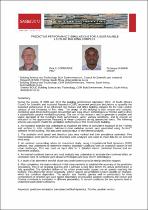JavaScript is disabled for your browser. Some features of this site may not work without it.
- ResearchSpace
- →
- Research Publications/Outputs
- →
- Conference Publications
- →
- View Item
| dc.contributor.author |
Conradie, Dirk CU

|
|
| dc.contributor.author |
Kumirai, T

|
|
| dc.date.accessioned | 2012-08-22T09:52:24Z | |
| dc.date.available | 2012-08-22T09:52:24Z | |
| dc.date.issued | 2012-06 | |
| dc.identifier.citation | Conradie, DCU and Kumirai, T. Predictive performance simulations for a sustainable lecture building complex. 4th CIB International Conference on Smart and Sustainable Lecture Building Complex, Sao Paulo, June 2012 | en_US |
| dc.identifier.uri | http://hdl.handle.net/10204/6060 | |
| dc.description | 4th CIB International Conference on Smart and Sustainable Lecture Building Complex, Sao Paulo, June 2012 | en_US |
| dc.description.abstract | During the course of 2009 and 2010 the building performance laboratory (BPL) of South Africa's Council for Scientific and Industrial Research (CSIR) undertook predictive simulations to quantifiy the expected performance of an advanced new lecture and office building complex for the East London campus of the University of Fort Hare. The design of the building is both unique and complex, combining wind-driven technologies (an aerofoil) and solar-driven technologies (a Trombe wall) to drive a substantially passive ventilation process. The aim of this research was to generate a useable and useful appraisal of the building's likely performance, under various conditions, and to provide an indication of the approximate frequency of those conditions during operational hours. The following process was used to model the ventilation performance of this mixed-mode building: 1) An insolation analysis was undertaken to establish the effect of cumulative exposure of the Trombe wall surface to solar radiation. Moment-in-time radiation reports were generated using EcotectTM software for the building. The data were used as input for the internal analysis, 2) The available wind speed and direction data were verified and their prevalence estimated. Five representative wind speeds and five directions were analysed and used as input data for an external wind study., 3) An external surrounding urban air movement study, using computational fluid dynamics (CFD) software, was undertaken to determine external boundary conditions from an extensive section of the urban landscape. This was used as input data for a detailed interior combined thermal and air-movement analysis, 4) An internal combined thermal and wind analysis was undertaken to estimate the combined effect on ventilation rates of combined wind-driven technologies and solar-driven technologies, 5) A study of an alternative aerofoil shape was undertaken to provide design decision-support. | en_US |
| dc.language.iso | en | en_US |
| dc.relation.ispartofseries | Workflow;9400 | |
| dc.subject | Building design | en_US |
| dc.subject | Lecture building complexes | en_US |
| dc.subject | Performance simulations | en_US |
| dc.subject | Green buildings | en_US |
| dc.subject | Computational fluid dynamics | en_US |
| dc.subject | Trombe | en_US |
| dc.subject | Aerofoil | en_US |
| dc.subject | Venturi | en_US |
| dc.subject | Predictive simulation | en_US |
| dc.title | Predictive performance simulations for a sustainable lecture building complex | en_US |
| dc.type | Conference Presentation | en_US |
| dc.identifier.apacitation | Conradie, D. C., & Kumirai, T. (2012). Predictive performance simulations for a sustainable lecture building complex. http://hdl.handle.net/10204/6060 | en_ZA |
| dc.identifier.chicagocitation | Conradie, Dirk CU, and T Kumirai. "Predictive performance simulations for a sustainable lecture building complex." (2012): http://hdl.handle.net/10204/6060 | en_ZA |
| dc.identifier.vancouvercitation | Conradie DC, Kumirai T, Predictive performance simulations for a sustainable lecture building complex; 2012. http://hdl.handle.net/10204/6060 . | en_ZA |
| dc.identifier.ris | TY - Conference Presentation AU - Conradie, Dirk CU AU - Kumirai, T AB - During the course of 2009 and 2010 the building performance laboratory (BPL) of South Africa's Council for Scientific and Industrial Research (CSIR) undertook predictive simulations to quantifiy the expected performance of an advanced new lecture and office building complex for the East London campus of the University of Fort Hare. The design of the building is both unique and complex, combining wind-driven technologies (an aerofoil) and solar-driven technologies (a Trombe wall) to drive a substantially passive ventilation process. The aim of this research was to generate a useable and useful appraisal of the building's likely performance, under various conditions, and to provide an indication of the approximate frequency of those conditions during operational hours. The following process was used to model the ventilation performance of this mixed-mode building: 1) An insolation analysis was undertaken to establish the effect of cumulative exposure of the Trombe wall surface to solar radiation. Moment-in-time radiation reports were generated using EcotectTM software for the building. The data were used as input for the internal analysis, 2) The available wind speed and direction data were verified and their prevalence estimated. Five representative wind speeds and five directions were analysed and used as input data for an external wind study., 3) An external surrounding urban air movement study, using computational fluid dynamics (CFD) software, was undertaken to determine external boundary conditions from an extensive section of the urban landscape. This was used as input data for a detailed interior combined thermal and air-movement analysis, 4) An internal combined thermal and wind analysis was undertaken to estimate the combined effect on ventilation rates of combined wind-driven technologies and solar-driven technologies, 5) A study of an alternative aerofoil shape was undertaken to provide design decision-support. DA - 2012-06 DB - ResearchSpace DP - CSIR KW - Building design KW - Lecture building complexes KW - Performance simulations KW - Green buildings KW - Computational fluid dynamics KW - Trombe KW - Aerofoil KW - Venturi KW - Predictive simulation LK - https://researchspace.csir.co.za PY - 2012 T1 - Predictive performance simulations for a sustainable lecture building complex TI - Predictive performance simulations for a sustainable lecture building complex UR - http://hdl.handle.net/10204/6060 ER - | en_ZA |






